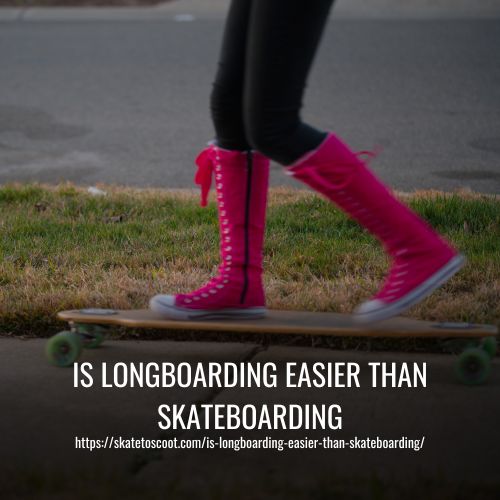As an Amazon Associate we earn from qualifying purchases.
Riding your longboard in the rain can be a great experience. It’s full of fun and a bit of a challenge, but if you’re feeling up to it you should definitely give it a try! However, there are a few precautionary steps you need to take before going for it.
First, make sure your board is ready for wet conditions by ensuring proper protection from potential damage. Be sure all bolts, nuts, and screws are tight – loose parts won’t grip as well in the rain. Also, apply a clear coat or wax on the deck to protect against water damage and discoloration.
And of course, never ride with poor visibility or on overly slippery surfaces! Keep an eye out for wet leaves and other hidden hazards so you don’t slip or fall off your board. Taking these precautions will help ensure that you have an enjoyable time while safely longboarding in the rain!

Before Your Ride
Before your ride, it’s important to make sure you have the right gear and safety precautions in place. Make sure you have a helmet, elbow pads, knee pads, and gloves to protect yourself from any potential falls.
Examine Your Deck for Scratches
Before you hit the road on your longboard, it’s important to examine your deck for scratches. Scuffed and worn decks are more likely to warp in wet conditions, which means that if you ride in the rain, you’ll need to carefully dry your board after each session.
Not all boards are suitable for wet weather either; look for a top-mount design that covers at least part of the wheels, or else prepare to be covered in mud and soaked through by the time you finish! When it comes to selecting clothing for a longboarding session in wet weather, opt for something that won’t be ruined if things get messy.
Finally, think about your shoe choice – heavy-duty water-resistant materials like hairspray and floor sealer can help but don’t apply them directly onto your grip tape. For added safety consider investing in some dedicated rain tires or a spare pair of wheels so as not to mess with expensive items. As longboard handling relies heavily on feet work, make sure your footwear is non-slip as well!
During Your Ride
When you’re skateboarding during rain, the first and most important thing to do is wear proper safety gear, including a helmet and safety pads. Once those pieces of protective gear are in place, you need to be even more mindful of different riding risks. Avoid riding over puddles and take care to keep your feet dry, and don’t blindly trust that puddles look smaller than they actually are. On top of that, be aware of painted lines on the road as these can also throw you off your board.
On top of that, it’s important that you maintain control over your board while skateboarding during rainy periods. If you lean too far when turning and allow water to enter through the deck of your board then you risk sliding out from underneath your feet and ending up hurt. To prevent this, ensure that you have bent your knees correctly and use your ankles to turn rather than relying on your weight.
After Your Ride
It is essential to properly care for your skateboard once you are done riding it. Start by unscrewing the wheels and taking out the bearings, then separate other components. Next, use a rag to dry all of these pieces off. Finally, use a hair dryer or any device that blows warm air to completely dry off the deck and any other areas.
It’s essential to clean the kingpin since it can easily rust if not regularly cleaned. If the kingpin is unable to be unscrewed for whatever reason, you will have to buy new trucks–which are considerably more expensive than just unscrewing the kingpin.
Make sure your board is elevated above whatever surface it’s resting on once you’ve dried and reassembled it, rather than having it directly on top of anything. Don’t forget to clean and lube your bearings as well; cleaning them with solvents such as acetone or mineral spirits helps keep them running smoothly while bearing lubricant or speed cream makes sure they stay in optimal condition.
Even if don’t follow these instructions after each ride, make sure you at least spin your wheels every now and then; this should become even more frequent during rainy season.
How Rainfall Water Could Do Harm To Your Longboard?
Rainfall can cause a lot of damage to your longboard if you’re not careful. The most important components to consider are your wheels and bearings. If these are made from ceramic or waterproof materials, then you should be safe from any major damage, but the wheels may become muddy or dirty with mud.
However, rainwater can cause more harm if you’re not equipped with proper protection. The rainwater can corrode metal parts like axles, trucks, and other components that are exposed on the board. It can also make wooden boards swell up if they are soaked in water for too long, so it’s important to make sure that your board is sealed properly and kept dry at all times.
Even if your board is made from waterproof materials, it still pays to take good care of it by keeping an eye on changes in temperature and humidity levels and drying off any parts that have gotten wet during rainfall events. This way, you’ll be able to ensure that your longboard will last longer than expected!
What Consequences of Riding a Longboard in the Rain?
Riding a longboard in the rain is not recommended, as it can lead to serious consequences. Firstly, there is less grip between your wheels and the wet surface, meaning you have to be extra careful when taking turns as your board can easily slip from underneath you if you make sudden or sharp turns.
Also, riding at high speeds on a wet surface is dangerous and more likely to cause loss of control than in dry conditions. This could potentially ruin your board itself and its components like bearings. If you don’t clean them afterward, they may corrode and rust, which will slow down your board over time. Also, not allowing enough air drying time may cause the wood to become brittle and warped.
In conclusion, riding a longboard in the rain is not recommended since it increases the risk of harm both to yourself and to the board itself. It’s always best to take precautions to ensure that you and your board remain safe.
How Do The Rains Affect Your Board’s Deck?
If you’ve got a longboard and it’s been raining, your board’s deck is going to be affected. The first thing that will happen is it will get wet, so you need to make sure that you dry it properly and keep it in a safe place.
The second effect of the rain is on the grip tape – as usual, this will get wet and dirty. If you don’t take the time to clean off the grip tape, its adherence may start to deteriorate and your board could become slippery over time. That’s why it’s important to clean up your grip tape after each rainy ride!
Can Your Longboard Get Wet?
It’s a reasonable question to ask – can my longboard get wet? Well, the answer is yes. While many longboards are designed to be durable and water-resistant, there are still several components of your board that might not react well when they come into contact with water.
This could mean that your longboard could wear out faster than usual, leading you to replace components more often. It’s important to take steps to protect your board from water so it lasts for as long as possible.
Your deck is particularly vulnerable; made from plywood layers including birch, bamboo, maple, koa, or oak wood, if left unpreserved it will absorb moisture and softens over time as you place weight on it – causing it to warp out of shape.
Similarly, grip tape needs some attention if exposed to moisture – excess mud can soak in and affect its effectiveness against friction. In this case, using a rubber cement pickup (available at art stores) along with a soft wire brush and microfiber cloth should do the trick.
Meanwhile, bearings become less effective when exposed to water as they lose their lubrication. To ensure its performance isn’t affected over time, it’s suggested that owners disassemble their bearings before drying the parts and then spray on some lubricant after they’re dry.
Fortunately, however, trucks typically won’t suffer much wear & tear even if exposed to moisture – through an inconvenient rusted axle nut might occur which can make adjustments difficult.
What Are The Advantages and Disadvantages Of Longboarding In The Rain?
The pros of longboarding in the rain are that it can be a great way to get some exercise and have fun. It can also be a great way to practice your skills and learn new tricks.
The cons, however, are that it is more dangerous than riding in dry conditions due to the increased risk of loss of control. Additionally, if you don’t take the time to clean and dry your board after each ride, it can lead to wear and tear on the components.
Advantages
There are plenty of advantages to longboarding in the rain. For starters, it’s an exciting and adventurous experience that will build up your skills as a more complete and knowledgeable rider. You have to be extra cautious when turning or reaching higher speeds on wet asphalt roads as compared to dry ones.
Additionally, riding with less traction on wet surfaces makes it easier to learn how to slide. This is especially beneficial for beginner riders who may find it difficult to do so otherwise. Sliding during rain can help riders pick up sliding techniques more quickly than on a dry surface.
Finally, there is just something special about the feeling of riding your board in the rain or just after the shower has ended. It is truly a unique experience that’s full of excitement and fun!
Disadvantages
Longboarding in the rain can present several disadvantages that you must be aware of. For example, a wet and slippery surface has less traction which can make turning difficult and dangerous, resulting in a longboard accident. Additionally, it’s important to be extra cautious when reaching higher speeds because there is more chance of losing control.
Damage to your board and bearings can also occur if proper care isn’t taken after riding in the rain. Your board may get sodden, making the wood weak and prone to warping, while your bearings could start to rust if they aren’t cleaned off properly afterward. Rusting bearings will slow down the longboard over time and may require replacement depending on their condition.
These are just some of the disadvantages to consider before going longboarding in wet conditions – so make sure you know what you’re getting yourself into!
FAQs
While it can be an exciting and adventurous experience, riding a longboard in the rain can be dangerous due to the increased risk of loss of control. It is important to take extra caution when turning or reaching higher speeds on wet asphalt roads as compared to dry ones.
A drop-through or top-mount longboard is generally recommended for riding in wet conditions as they provide more stability and control. Additionally, it’s important to make sure that your board has a good grip tape to ensure maximum traction on wet surfaces.
It is not recommended to ride a longboard in heavy rain as the risk of losing control increases significantly due to the lack of traction on wet surfaces. Additionally, heavy rain can cause damage to your board and bearings if proper care isn’t taken after riding.
After riding your board in the rain, it is important to clean and dry your board properly. This will help prevent wear and tear on the components and ensure that your bearings don’t start to rust. Additionally, you may want to disassemble your bearings before drying them and then spray on some lubricant after they’re dry.
Yes, there are a few safety precautions you should take when longboarding in the rain. First, make sure to wear appropriate clothing and footwear that will keep you dry and provide a good grip on wet surfaces. Additionally, it is important to reduce your speed and take extra caution when turning or reaching higher speeds on wet asphalt roads as compared to dry ones. Finally, make sure to always wear a helmet and other protective gear to minimize the risk of injury.
Yes, it is possible to longboard on wet pavement, but there are some important things to consider. Riding in the rain can be dangerous, so it’s important to take precautions to protect yourself. Additionally, wet pavement can damage your longboard, so it’s important to take steps to prevent this.
Conclusion
In conclusion, being able to ride a longboard in the rain is definitely possible. But, you should be mindful of certain safety precautions that need to be taken and the worst-case scenarios that can happen if those precautions are not followed.
By taking into consideration all of the necessary safety factors, you can enjoy riding your longboard in wet weather conditions and minimize the risks associated with it.
Amazon and the Amazon logo are trademarks of Amazon.com, Inc, or its affiliates.



